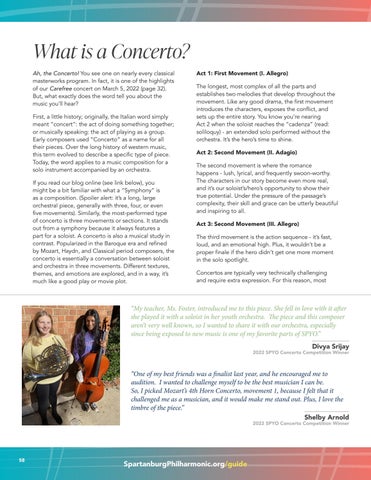What is a Concerto? Ah, the Concerto! You see one on nearly every classical masterworks program. In fact, it is one of the highlights of our Carefree concert on March 5, 2022 (page 32). But, what exactly does the word tell you about the music you’ll hear? First, a little history; originally, the Italian word simply meant “concert”: the act of doing something together; or musically speaking: the act of playing as a group. Early composers used “Concerto” as a name for all their pieces. Over the long history of western music, this term evolved to describe a specific type of piece. Today, the word applies to a music composition for a solo instrument accompanied by an orchestra. If you read our blog online (see link below), you might be a bit familiar with what a “Symphony” is as a composition. (Spoiler alert: it’s a long, large orchestral piece, generally with three, four, or even five movements). Similarly, the most-performed type of concerto is three movements or sections. It stands out from a symphony because it always features a part for a soloist. A concerto is also a musical study in contrast. Popularized in the Baroque era and refined by Mozart, Haydn, and Classical period composers, the concerto is essentially a conversation between soloist and orchestra in three movements. Different textures, themes, and emotions are explored, and in a way, it’s much like a good play or movie plot.
Act 1: First Movement (I. Allegro) The longest, most complex of all the parts and establishes two melodies that develop throughout the movement. Like any good drama, the first movement introduces the characters, exposes the conflict, and sets up the entire story. You know you’re nearing Act 2 when the soloist reaches the “cadenza” (read: soliloquy) - an extended solo performed without the orchestra. It’s the hero’s time to shine. Act 2: Second Movement (II. Adagio) The second movement is where the romance happens - lush, lyrical, and frequently swoon-worthy. The characters in our story become even more real, and it’s our soloist’s/hero’s opportunity to show their true potential. Under the pressure of the passage’s complexity, their skill and grace can be utterly beautiful and inspiring to all. Act 3: Second Movement (III. Allegro) The third movement is the action sequence - it’s fast, loud, and an emotional high. Plus, it wouldn’t be a proper finale if the hero didn’t get one more moment in the solo spotlight. Concertos are typically very technically challenging and require extra expression. For this reason, most
“My teacher, Ms. Foster, introduced me to this piece. She fell in love with it after she played it with a soloist in her youth orchestra. The piece and this composer aren’t very well known, so I wanted to share it with our orchestra, especially since being exposed to new music is one of my favorite parts of SPYO.” Divya Srijay
2022 SPYO Concerto Competition Winner
“One of my best friends was a finalist last year, and he encouraged me to audition. I wanted to challenge myself to be the best musician I can be. So, I picked Mozart’s 4th Horn Concerto, movement 1, because I felt that it challenged me as a musician, and it would make me stand out. Plus, I love the timbre of the piece.” Shelby Arnold
2022 SPYO Concerto Competition Winner
58
SpartanburgPhilharmonic.org/guide

















